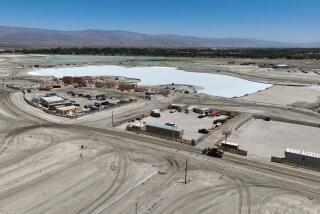International Body Looks at County’s Communities
- Share via
Appropriately facing the model homes in Barratt America’s latest planned community, 450 developers, financiers and planners from 31 countries gathered Monday in Mission Viejo to inaugurate the International New Town Assn.’s first meeting in the United States since the group was founded 10 years ago.
The organization, created to deal with the complexities of planned development, is meeting in Orange County for three days of conferences and symposiums centering on planned communities and for three more days in San Francisco for discussions focusing on urban redevelopment.
And to an international association concerned with the creation of large, planned communities, there are few more eye-opening areas for study than Orange County--home of 32 planned communities, of which 20 still are under development.
Delegates from as far away as Thailand and China and as near as Canada found the posh planned communities of Orange County to be quite different from the normally government-supported, low-to-moderate income housing in their countries.
Less Lavish Abroad
In most other countries, several of the delegates said, planned communities generally have none of the lavish accouterments--such as cathedral ceilings, tile roofs, equestrian trails and Olympic-size swimming pools--available in the developments that dot southern Orange County.
Henk Fleury, director of the Almere planned development project in the Netherlands, said development also is “more private” in the United States.
In the Netherlands, he said, as much as 50% of a development often is given to row housing used for rentals, which makes it possible to build larger owner-occupied homes on larger lots than is the norm in the United States. But, he said, that would not be possible without the government subsidies that are poured into planned developments in his country.
The weeklong conference features a number of tours of planned communities and urban renewal projects in Southern California, including Mission Viejo--the county’s first planned community.
On Monday, while delegates looked at the tastefully appointed models of Barratt’s 160-unit Spanish-style Ventana project and lunched on Mexican food, speakers talked about economic conditions affecting housing and the differences between the creation of planned communities overseas and in the United States. Luncheon speakers included Sir Lawrie Barratt, chairman of Barratt Developments PLC in England; John Swanson, president of Barratt American, and John K. Geoghegan, California’s business, transportation and housing secretary.
Decried Developer Fees
Not surprisingly, Swanson--a Mission Viejo resident--decried the use of developer fees local governments levy against builders to help pay for the schools, parks and sewer, street and water systems demanded by a large housing development.
Swanson and several other speakers linked the cost of improving or repairing infrastructure directly to the price of a new home, saying that the buyers of new homes in the United States often are penalized by an “unfair bias” because of those fees.
In the United Kingdom, Swanson said, street and infrastructure costs are paid for from tax revenue raised within the affected community.
He said homes in planned communities in Britain are smaller and not as stylish as the gabled Spanish homes in the Ventana project. Construction materials differ, with brick being more commonplace, and land costs are substantially more expensive in England than in Orange County.
“In Great Britain, we compete for land, here you compete for buyers,” quipped Barratt.
On Wednesday, delegates are scheduled to take a look at some of the inducements developers in Southern California use to lure buyers.
Scheduled events include a presentation about the Irvine Co.’s 68,000-acre holdings and the retail and residential uses of that land, followed by a tour of the Newport Center commercial complex and its Fashion Island Shopping Center.
Other tours before the conference moves to San Francisco include reviews of redevelopment efforts in Santa Ana, Costa Mesa and Los Angeles.
More to Read
Sign up for Essential California
The most important California stories and recommendations in your inbox every morning.
You may occasionally receive promotional content from the Los Angeles Times.













